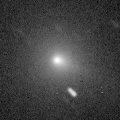
|
New bright comet discovered by the All-Sky Automated Survey for Supernovae (ASASSN). Now it is bright as 9.8 mag (Aug. 1, Chris Wyatt). It is expected to brighten up to 7.5 mag in October. In the Northern Hemisphere, it stays observable in excellent condition for a long time. In the Southern Hemisphere, it is observable in good condition now. But it will be getting lower in September, and it will be unobservable for a long time after October.
Date(TT) R.A. (2000) Decl. Delta r Elong. m1 Best Time(A, h)
Aug. 19 3 21.87 1 31.3 1.240 1.697 97 9.3 3:51 (319, 49)
Aug. 26 3 32.61 5 15.0 1.142 1.655 100 9.0 3:58 (325, 55)
|

|
It brightened up to 7.1 mag from May to June (June 21, Juan Jose Gonzalez). Now it is fading. But it is bright as 9.2 mag still now (Aug. 10, Marco Goiato). In the Southern Hemisphere, it is observable in good condition after this. It will never be observable again in the Northern Hemisphere.
Date(TT) R.A. (2000) Decl. Delta r Elong. m1 Best Time(A, h)
Aug. 19 14 49.96 -40 2.6 1.631 1.868 86 9.5 20:14 ( 35, 2)
Aug. 26 15 1.64 -42 39.5 1.745 1.913 83 9.7 20:04 ( 34, 0)
|
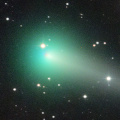
|
It brightened up to 6.2 mag in April (Apr. 7, Juan Jose Gonzalez). Now it is fading. But it is bright as 10.7 mag still now (Aug. 12, Seiichi Yoshida). It stays observable for a long time after this.
Date(TT) R.A. (2000) Decl. Delta r Elong. m1 Best Time(A, h)
Aug. 19 3 48.93 23 24.1 1.680 1.897 85 10.4 3:51 (284, 60)
Aug. 26 3 54.03 23 29.3 1.678 1.980 91 10.6 3:58 (291, 66)
|

|
Now it is bright as 10.9 mag (Aug. 10, Marco Goiato). It is observable in excellent condition in the Southern Hemisphere. It locates low in the Northern Hemisphere.
Date(TT) R.A. (2000) Decl. Delta r Elong. m1 Best Time(A, h)
Aug. 19 17 31.81 -37 43.5 0.926 1.656 117 11.1 20:14 ( 7, 17)
Aug. 26 17 47.29 -37 37.0 0.989 1.676 113 11.3 20:04 ( 7, 17)
|
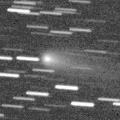
|
Now it is bright as 12.6 mag (Aug. 1, Chris Wyatt). It stays 12 mag until September. In the Southern Hemisphere, it stays at the same altitude in the morning sky. In the Northern Hemisphere, it will be getting higher slowly.
Date(TT) R.A. (2000) Decl. Delta r Elong. m1 Best Time(A, h)
Aug. 19 5 44.05 11 59.5 1.461 1.307 60 11.8 3:51 (277, 31)
Aug. 26 6 5.06 12 2.1 1.470 1.338 62 11.8 3:58 (279, 33)
|
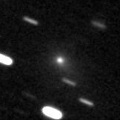
|
Now it is 14.0 mag (July 28, Thomas Lehmann). It will stay bright as 10 mag for a long time from autum to next spring. In the Southern Hemisphere, it stays observable in good condition until next February. It is appearing in the morning sky also in the Northern Hemispehre. It stays observable for a long time after this until the comet fades out.
Date(TT) R.A. (2000) Decl. Delta r Elong. m1 Best Time(A, h)
Aug. 19 5 15.48 -3 52.4 3.960 3.752 70 12.7 3:51 (296, 26)
Aug. 26 5 20.32 -3 32.8 3.823 3.703 75 12.6 3:58 (302, 32)
|

|
Now it is visible visually at 13.9 mag (Aug. 14, Chris Wyatt).
Date(TT) R.A. (2000) Decl. Delta r Elong. m1 Best Time(A, h)
Aug. 19 21 19.38 -14 11.6 4.821 5.825 171 13.2 23:27 ( 0, 41)
Aug. 26 21 16.18 -14 20.7 4.844 5.823 164 13.2 22:56 ( 0, 41)
|

|
Now it is 13.6 mag (Aug. 14, Chris Wyatt). It is observable at 13-14 mag in good condition in summer.
Date(TT) R.A. (2000) Decl. Delta r Elong. m1 Best Time(A, h)
Aug. 19 21 41.75 5 43.7 1.744 2.722 161 13.4 23:47 ( 0, 61)
Aug. 26 21 15.13 2 45.6 1.751 2.720 159 13.4 22:53 ( 0, 58)
|
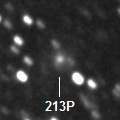
|
Now it is bright as 13.5 mag (Aug. 14, Chris Wyatt). It was expected to brighten up to 12 mag in summer. But actually, it is fainter than expected. It is observable in excellent condition in the Southern Hemisphere. It locates somewhat low in the Northern Hemisphere.
Date(TT) R.A. (2000) Decl. Delta r Elong. m1 Best Time(A, h)
Aug. 19 18 48.70 -25 57.5 1.157 2.004 134 13.4 20:57 ( 0, 29)
Aug. 26 18 50.67 -24 56.3 1.202 1.997 128 13.4 20:32 ( 0, 30)
|
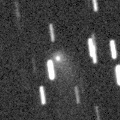
|
Now it is 15.0 mag (July 7, Ken-ichi Kadota). In the Northern Hemisphere, it will brighten up to 14 mag from summer to winter, and it will be observable in excellent condition. It is not observable at all after this in the Southern Hemisphere.
Date(TT) R.A. (2000) Decl. Delta r Elong. m1 Best Time(A, h)
Aug. 19 0 10.64 62 22.2 2.875 3.211 100 13.9 2:23 (180, 63)
Aug. 26 23 53.96 64 57.1 2.832 3.206 102 13.8 1:39 (180, 60)
|

|
Now it is 14.1 mag (June 30, Chris Wyatt). It stays 14 mag from spring to summer. It locates somewhat low in the Northern Hemisphere. The perihelion distance increased from 2.4 a.u. to 2.9 a.u. in this apparition. So it will not be bright as before.
Date(TT) R.A. (2000) Decl. Delta r Elong. m1 Best Time(A, h)
Aug. 19 15 57.17 -24 4.7 2.638 2.925 96 14.5 20:14 ( 32, 23)
Aug. 26 16 3.09 -24 28.8 2.727 2.922 90 14.6 20:04 ( 34, 22)
|

|
Now it is 14.1 mag (Aug. 14, Chris Wyatt). It will be observable at 14 mag for a long time from 2017 to 2018.
Date(TT) R.A. (2000) Decl. Delta r Elong. m1 Best Time(A, h)
Aug. 19 16 23.34 22 36.5 3.907 4.069 91 14.5 20:14 ( 68, 64)
Aug. 26 16 18.11 22 8.8 3.989 4.045 85 14.6 20:04 ( 73, 60)
|
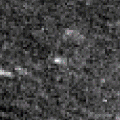
|
Now it is 18.8 mag (Aug. 2, Mike Olason). Return of a new periodic comet which brightened up to 13 mag in 2004. It will be observable in excellent condition in autumn. It is expected to brighten up to 14 mag, if the comet is as bright as when it was discovered. But actually, it is not brightening as expected.
Date(TT) R.A. (2000) Decl. Delta r Elong. m1 Best Time(A, h)
Aug. 19 2 14.61 -1 22.5 1.117 1.789 114 15.1 3:51 (346, 53)
Aug. 26 2 23.50 -0 34.7 1.053 1.772 118 14.9 3:58 (356, 54)
|

|
Now it is 15.3 mag (July 8, Ken-ichi Kadota). It is expected to brighten up to 9 mag in summer in 2018. In the Northern Hemisphere, it stays observable until 2018 summer while the comet will be brightening. In the Southern Hemisphere, it is hardly observable in 2017, but it will be observable in good condition in 2018.
Date(TT) R.A. (2000) Decl. Delta r Elong. m1 Best Time(A, h)
Aug. 19 17 8.50 42 26.0 4.185 4.386 94 15.1 20:14 (127, 77)
Aug. 26 17 5.61 40 19.8 4.175 4.329 91 15.0 20:04 (114, 74)
|

|
Now it is 17.5 mag (Aug. 6, Jean-Francois Soulier). It will pass the perihelion on Oct. 27. In the Southern Hemisphere, it stays observable while the comet will be brightening, until early October when the comet will brighten up to 9 mag. In the Northern Hemisphere, it is not observable at all in this apparition.
Date(TT) R.A. (2000) Decl. Delta r Elong. m1 Best Time(A, h)
Aug. 19 15 3.17 -77 18.7 1.120 1.633 99 15.5 20:14 ( 10,-26)
Aug. 26 14 23.76 -72 49.7 1.104 1.522 91 15.1 20:04 ( 17,-25)
|

|
Now it is 15.8 mag (July 8, Ken-ichi Kadota). It is expected to brighten up to 11-12 mag from 2018 to 2019. In the Northern Hemisphere, it stays observable in good condition while the comet will be brightening gradually. In the Southern Hemisphere, it is not observable until 2018 October.
Date(TT) R.A. (2000) Decl. Delta r Elong. m1 Best Time(A, h)
Aug. 19 15 2.15 55 48.3 4.467 4.269 72 15.2 20:14 (138, 53)
Aug. 26 14 58.06 54 39.7 4.459 4.218 69 15.1 20:04 (135, 50)
|
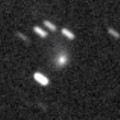
|
Now it is 15.4 mag (July 26, Toshiyuki Takahashi). It stays observable at 16 mag for a long time from 2017 to 2018.
Date(TT) R.A. (2000) Decl. Delta r Elong. m1 Best Time(A, h)
Aug. 19 2 33.94 29 4.2 4.087 4.383 100 15.5 3:51 (293, 77)
Aug. 26 2 28.74 28 21.5 3.947 4.370 108 15.4 3:58 (334, 83)
|

|
Now it is 16.7 mag (July 18, Ken-ichi Kadota). It stays observable at 16 mag unil the end of 2017.
Date(TT) R.A. (2000) Decl. Delta r Elong. m1 Best Time(A, h)
Aug. 19 3 34.62 3 56.7 5.690 5.841 93 15.4 3:51 (313, 49)
Aug. 26 3 36.61 3 38.4 5.613 5.868 99 15.4 3:58 (324, 53)
|

|
It has not been observed yet in this apparition. The condition of this apparition is worst. It must have brightened up to 10 mag in spring, but it is not observable at all.
Date(TT) R.A. (2000) Decl. Delta r Elong. m1 Best Time(A, h)
Aug. 19 9 10.36 7 3.2 2.833 1.854 11 15.4 3:51 (251,-14)
Aug. 26 9 25.38 5 44.4 2.881 1.916 14 15.6 3:58 (255,-11)
|

|
Now it is 17.0 mag (May 29, iTelescope Observatory, Siding Spring). It will brighten up to 14.5 mag in winter. In the Southern Hemisphere, it stays observable in excellent condition until spring in 2018. In the Northern Hemisphere, it stays unobservable until 2018.
Date(TT) R.A. (2000) Decl. Delta r Elong. m1 Best Time(A, h)
Aug. 19 2 42.31 -77 1.2 2.102 2.578 106 15.7 3:51 (356,-22)
Aug. 26 3 1.39 -78 5.2 2.083 2.529 104 15.6 3:58 (357,-23)
|
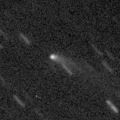
|
Now it is 16.5 mag (July 26, Toshiyuki Takahashi). It was observed at 17 mag in 2016. In 2017, it will be observable at 15.5 mag in good condition from summer to autumn.
Date(TT) R.A. (2000) Decl. Delta r Elong. m1 Best Time(A, h)
Aug. 19 1 43.64 15 2.6 2.248 2.847 116 15.7 3:51 (357, 70)
Aug. 26 1 44.12 15 44.5 2.176 2.853 122 15.7 3:28 ( 0, 71)
|
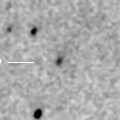
|
First return of a new periodic comet discovered in 2000. Now it is 17.3 mag (July 17, Mike Olason). It will brighten rapidly, and it is expected to be observable at 15.5 mag in good condition from July to September. But actually, it is fainter than this ephemeris.
Date(TT) R.A. (2000) Decl. Delta r Elong. m1 Best Time(A, h)
Aug. 19 1 17.56 -9 15.5 1.817 2.584 129 15.7 3:29 ( 0, 46)
Aug. 26 1 16.34 -8 53.9 1.770 2.596 136 15.7 3:00 ( 0, 46)
|
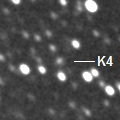
|
Now it is 15.7 mag (July 18, Ken-ichi Kadota). It stays 16 mag for a long time until summer in 2018. In the Southern Hemisphere, it stays observable in excellent condition until autumn. It locates low in the Northern Hemisphere.
Date(TT) R.A. (2000) Decl. Delta r Elong. m1 Best Time(A, h)
Aug. 19 16 50.61 -31 11.5 2.517 3.001 108 15.8 20:14 ( 17, 22)
Aug. 26 16 55.38 -30 30.2 2.572 2.969 103 15.8 20:04 ( 20, 21)
|

|
Now it is 18.4 mag (May 31, iTelescope Observatory, Siding Spring). It will brighten rapidly, up to 15 mag in autumn, and will be observable in good condition in the Northern Hemisphere. It locates low in the Southern Hemisphere.
Date(TT) R.A. (2000) Decl. Delta r Elong. m1 Best Time(A, h)
Aug. 19 4 2.47 21 38.5 1.743 1.908 83 16.4 3:51 (284, 56)
Aug. 26 4 16.28 23 0.4 1.678 1.905 86 16.2 3:58 (286, 61)
|

|
Now it is 16.3 mag (July 7, Ken-ichi Kadota). It stays 16 mag from 2016 to 2017. In the Northern Hemisphere, it stays observable in good condition for a long time. In the Southern Hemisphere, it will never be observable again.
Date(TT) R.A. (2000) Decl. Delta r Elong. m1 Best Time(A, h)
Aug. 19 17 49.39 65 13.3 6.401 6.478 89 16.5 20:14 (176, 60)
Aug. 26 17 47.46 64 47.4 6.418 6.490 89 16.5 20:04 (172, 60)
|
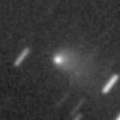
|
Now it is 16.8 mag (July 6, CAO, San Pedro de Atacama). It will brighten up to 16 mag in summer. It will be observable in excellent condition in the Southern Hemisphere. It will be getting higher gradually in the morning sky also in the Northern Hemisphere.
Date(TT) R.A. (2000) Decl. Delta r Elong. m1 Best Time(A, h)
Aug. 19 21 26.78 -26 52.6 1.525 2.516 164 16.5 23:34 ( 0, 28)
Aug. 26 21 20.24 -25 3.3 1.555 2.528 159 16.6 23:00 ( 0, 30)
|
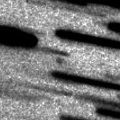
|
Now it is 19.0 mag (July 26, Jean-Gabriel Bosch). It will brighten very rapidly, and brighten up to 10 mag from October to December. It is observable in good condition in the Northern Hemisphere. It locates very low for a long time in the Southern Hemisphere.
Date(TT) R.A. (2000) Decl. Delta r Elong. m1 Best Time(A, h)
Aug. 19 6 26.49 21 27.6 2.113 1.652 49 17.4 3:51 (262, 27)
Aug. 26 6 49.48 21 41.1 2.022 1.597 51 16.7 3:58 (263, 29)
|

|
Hilda-type minor planet, but the cometary activity was detected on July 3. Now it is bright as 16.5 mag (July 3, G. J. Leonard).
Date(TT) R.A. (2000) Decl. Delta r Elong. m1 Best Time(A, h)
Aug. 19 21 3.26 1 24.8 2.413 3.386 161 16.7 23:11 ( 0, 56)
Aug. 26 20 59.41 0 38.8 2.448 3.403 157 16.8 22:40 ( 0, 56)
|

|
Now it is 17.6 mag (June 30, ATLAS-MLO, Mauna Loa). It brightens up to 16.5-17 mag in August, and it will be observable in good condition.
Date(TT) R.A. (2000) Decl. Delta r Elong. m1 Best Time(A, h)
Aug. 19 17 14.14 4 15.6 0.435 1.223 108 16.8 20:14 ( 24, 57)
Aug. 26 17 37.85 7 40.6 0.468 1.237 107 16.9 20:04 ( 23, 61)
|

|
It brightened up to 11 mag from spring to summer in 2016. Now it is 17.4 mag (July 14, Ken-ichi Kadota). It stays observable for a long time after this, but it will be fainter than 18 mag in October.
Date(TT) R.A. (2000) Decl. Delta r Elong. m1 Best Time(A, h)
Aug. 19 19 36.69 -20 29.1 2.610 3.499 146 17.1 21:45 ( 0, 35)
Aug. 26 19 33.54 -20 41.9 2.708 3.534 139 17.2 21:14 ( 0, 34)
|

|
Now it is 17.9 mag (June 2, MASTER-OAFA Observatory). It will brighten up to 14 mag from autumn to winter in 2018, and it will be observable in excellent condition in the Northern Hemisphere. In 2017, it is observable at 17 mag in excellent condition in the Southern Hemisphere.
Date(TT) R.A. (2000) Decl. Delta r Elong. m1 Best Time(A, h)
Aug. 19 0 14.74 -45 0.5 3.382 4.169 135 17.2 2:26 ( 0, 10)
Aug. 26 0 8.67 -45 33.9 3.323 4.128 137 17.1 1:53 ( 0, 10)
|

|
It will pass the perihelion in 2019. However, it has not been brightening since the discovery in 2010. It will be getting higher gradually in the morning sky in the Northern Hemisphere. It is not observable for a long time in the Southern Hemisphere.
Date(TT) R.A. (2000) Decl. Delta r Elong. m1 Best Time(A, h)
Aug. 19 6 17.14 65 23.1 9.459 9.058 63 17.2 3:51 (211, 40)
Aug. 26 6 24.02 65 56.1 9.374 9.043 67 17.1 3:58 (210, 43)
|

|
Now it is 17.4 mag (July 20, Yuji Ohshima). It is expected to brighten up to 13-14 mag from 2018 to 2019. In the Northern Hemisphere, it stays observable in good condition for a long time. In the Southern Hemisphere, it is not observable until summer in 2018.
Date(TT) R.A. (2000) Decl. Delta r Elong. m1 Best Time(A, h)
Aug. 19 19 21.31 68 18.6 5.490 5.659 94 17.2 21:27 (180, 57)
Aug. 26 19 7.22 67 5.3 5.432 5.612 95 17.2 20:46 (180, 58)
|
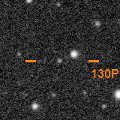
|
Now it is 17.9 mag (May 27, T. Ikemura, H. Sato). It will be brightening slowly until autumn when it becomes 16.5-17 mag. It will be getting lower gradually in the Northern Hemisphere.
Date(TT) R.A. (2000) Decl. Delta r Elong. m1 Best Time(A, h)
Aug. 19 14 48.11 -16 15.4 2.202 2.234 78 17.3 20:14 ( 51, 21)
Aug. 26 14 57.58 -17 11.3 2.251 2.203 74 17.3 20:04 ( 52, 19)
|
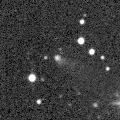
|
It was observed at 17 mag in 2016. It stays 17 mag also in 2017. It is observable in good condition in the Northern Hemisphere. It locates very low in the Southern Hemisphere.
Date(TT) R.A. (2000) Decl. Delta r Elong. m1 Best Time(A, h)
Aug. 19 6 5.80 32 11.4 3.301 2.848 55 17.5 3:51 (253, 36)
Aug. 26 6 16.97 32 25.4 3.245 2.868 59 17.4 3:58 (255, 40)
|

|
In the Northern Hemisphere, it will be observable at 17 mag in excellent condition from autumn to winter. It locates low in the Southern Hemisphere.
Date(TT) R.A. (2000) Decl. Delta r Elong. m1 Best Time(A, h)
Aug. 19 4 51.82 28 48.8 3.178 3.006 71 17.6 3:51 (265, 49)
Aug. 26 5 0.81 29 23.9 3.098 3.014 75 17.5 3:58 (267, 55)
|
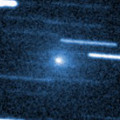
|
It brightened up to 11 mag from March to April. Now it is fading. It has faded down to 12.7 mag in late May (May 26, iTelescope Observatory, Siding Spring). No observations have been reported after that.
Date(TT) R.A. (2000) Decl. Delta r Elong. m1 Best Time(A, h)
Aug. 19 4 17.71 6 27.2 2.175 2.276 82 17.5 3:51 (299, 44)
Aug. 26 4 21.69 5 52.5 2.169 2.364 88 17.8 3:58 (307, 49)
|

|
It brightened up to 11.5 mag from late March to early April (Mar. 24, Andrew Pearce). Now it is fading. It has already faded down to 17.8 mag (June 30, CAO, San Pedro de Atacama). Bright 12-mag new fragment BT was discovered on Feb. 10, but now it is faint as 18.9 mag (June 2, CAO, San Pedro de Atacama). It will be fainter than 18 mag in September.
Date(TT) R.A. (2000) Decl. Delta r Elong. m1 Best Time(A, h)
Aug. 19 3 13.16 6 52.9 1.744 2.135 98 17.5 3:51 (317, 55)
Aug. 26 3 14.57 6 47.3 1.715 2.196 104 17.7 3:58 (330, 59)
|
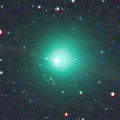
|
It brightened up to 7.2 mag in spring (Mar. 24, Marco Goiato). Now it is 16.9 mag (June 2, T. Ikemura, H. Sato). It will be fainter than 18 mag in late August. It is observable in good condition in the Southern Hemisphere. It locates low in the Northern Hemisphere.
Date(TT) R.A. (2000) Decl. Delta r Elong. m1 Best Time(A, h)
Aug. 19 20 32.73 -26 19.9 1.470 2.434 156 17.6 22:40 ( 0, 29)
Aug. 26 20 22.73 -26 16.5 1.577 2.495 148 17.9 22:03 ( 0, 29)
|

|
Peculiar asteroid moving along a comet-like orbit. It is observable at 18 mag in good condition from August to September. It locates somewhat low in the Southern Hemisphere.
Date(TT) R.A. (2000) Decl. Delta r Elong. m1 Best Time(A, h)
Aug. 19 22 38.93 17 39.5 2.873 3.765 147 17.8 0:51 ( 0, 73)
Aug. 26 22 35.08 17 52.4 2.846 3.764 151 17.8 0:19 ( 0, 73)
|

|
Peculiar asteroid moving along a comet-like orbit. In the Southern Hemisphere, it is observable at 18 mag in good condition from July to August. It is not observable in the Northern Hemisphere.
Date(TT) R.A. (2000) Decl. Delta r Elong. m1 Best Time(A, h)
Aug. 19 23 3.79 -55 7.6 0.890 1.761 135 17.8 1:20 ( 0, 0)
Aug. 26 21 20.66 -56 6.1 0.942 1.791 133 18.0 22:54 ( 0, -1)
|
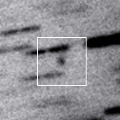
|
Now it is 18.3 mag (June 20, P. Camilleri, H. Williams). It stays observable at 18 mag from spring to summer. It is observable in excellent condition in the Southern Hemisphere. It locates low in the Northern Hemisphere.
Date(TT) R.A. (2000) Decl. Delta r Elong. m1 Best Time(A, h)
Aug. 19 22 9.12 -34 5.5 4.652 5.606 158 17.8 0:21 ( 0, 21)
Aug. 26 22 5.04 -33 53.8 4.690 5.630 156 17.9 23:45 ( 0, 21)
|

|
Now it is 16.7 mag (June 27, Hidetaka Sato). It will fade out after this, and it will be fainter than 18 mag in August.
Date(TT) R.A. (2000) Decl. Delta r Elong. m1 Best Time(A, h)
Aug. 19 17 43.55 26 15.7 3.582 4.011 107 17.8 20:14 ( 31, 80)
Aug. 26 17 44.44 25 43.0 3.681 4.049 104 18.0 20:04 ( 44, 78)
|
|
![]()
 C/2017 K6 ( Jacques )
C/2017 K6 ( Jacques ) 47P/Ashbrook-Jackson
47P/Ashbrook-Jackson 352P/2017 L1 ( Skiff )
352P/2017 L1 ( Skiff ) C/2017 K4 ( ATLAS )
C/2017 K4 ( ATLAS ) 145P/Shoemaker-Levy 5
145P/Shoemaker-Levy 5 C/2014 OE4 ( PanSTARRS )
C/2014 OE4 ( PanSTARRS ) C/2017 D2 ( Barros )
C/2017 D2 ( Barros ) 24P/Schaumasse
24P/Schaumasse (457175) 2008 GO98
(457175) 2008 GO98 189P/NEAT
189P/NEAT 81P/Wild 2
81P/Wild 2 (944) Hidalgo
(944) Hidalgo C/2010 U3 ( Boattini )
C/2010 U3 ( Boattini ) C/2017 M4 ( ATLAS )
C/2017 M4 ( ATLAS ) 130P/McNaught-Hughes
130P/McNaught-Hughes 188P/LINEAR-Mueller
188P/LINEAR-Mueller 90P/Gehrels 1
90P/Gehrels 1 C/2017 E1 ( Borisov )
C/2017 E1 ( Borisov ) 73P/Schwassmann-Wachmann 3
73P/Schwassmann-Wachmann 3 2P/Encke
2P/Encke 2016 ND21
2016 ND21 2016 VY17
2016 VY17 C/2015 H2 ( PanSTARRS )
C/2015 H2 ( PanSTARRS ) C/2016 B1 ( NEOWISE )
C/2016 B1 ( NEOWISE )![]()




































